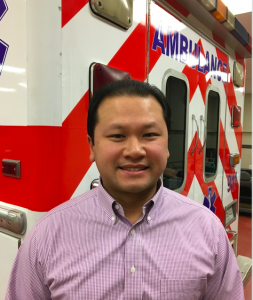Emergency Medical Technician and Paramedic
Mentor – Steve Nguyen
 Steve is the Coordinator of the Emergency Medical Services Program at Tulsa Tech, where you can become certified as an emergency medical technician (EMT) while you are still in high school. After graduation, you can then take the additional courses required to become a Paramedic. Steve first got his EMT certification and started working for emergency medical service providers while he took classes to become a paramedic. He then completed a bachelor’s in business management, with the idea of working his way up the corporate ladder at EMSA, where he was employed as a paramedic. But Steve’s career path changed after he was hired as a part-time instructor at Tulsa Tech and found he also had a passion for teaching. He went back to school once more for a master’s in education and now heads the program.
Steve is the Coordinator of the Emergency Medical Services Program at Tulsa Tech, where you can become certified as an emergency medical technician (EMT) while you are still in high school. After graduation, you can then take the additional courses required to become a Paramedic. Steve first got his EMT certification and started working for emergency medical service providers while he took classes to become a paramedic. He then completed a bachelor’s in business management, with the idea of working his way up the corporate ladder at EMSA, where he was employed as a paramedic. But Steve’s career path changed after he was hired as a part-time instructor at Tulsa Tech and found he also had a passion for teaching. He went back to school once more for a master’s in education and now heads the program.
Like many young people, Steve was not sure what he wanted to do when he graduated from high school. But he knew he wanted a career doing something that would give him passion, pride and purpose (his “three P’s”). He decided to get an EMT certification during his junior year of college and found the “three P’s” he was looking for in a career…helping people in medical emergencies and later combined this passion with the passion he had for teaching. Steve also gives back by serving the community as a volunteer for the educational foundation at Union High School and for the American Heart Association.
The growth in the middle-aged and elderly population is expected to lead to an increase in age-related health emergencies, such as heart attacks and strokes, and create a strong demand for EMT and Paramedic services. There are also opportunities for professional growth. Emergency Room Registered Nurses or Paramedic Supervisors are common next steps for Paramedics who want to move up the career ladder and medical employers often pay the cost of additional training.
My Career Path
I feel fortunate because I am a first generation American from a family of immigrants. When my parents lived in Vietnam, there were wide income disparities and the best career opportunities went to the wealthy. But education, not wealth, is the great equalizer in America. That is why my dad wanted his children to get a good education. I really did not know what I wanted to do for a career after I graduated from high school. My five other siblings all went to college and have professional careers in engineering and computer science, careers I was not interested in pursuing. Because I was not sure what I wanted to do, I didn’t want to waste my time and money. So I started out at Tulsa Community College to take my basic courses and lived at home to hold down my expenses. I got a lot of grief for that. I was always able to pay for my education without having any debt by watching my expenses and working while I was going to school. I went to OU after two years of community college and began taking classes in accounting and finance to become a CPA. My dad told me that I should become either a doctor or a CPA because death and taxes are always going to create a need for both. I was about thirty hours from graduating when I took an EMT class that was about sixteen weeks long. I liked it and flourished in the program. I decided to get a job as an EMT and also take classes to become a Paramedic. After I had gone to college to become a CPA and then told my dad that I wanted to become an EMT, it was almost a disappointment to him. I decided though that I wanted to do something I was passionate about, that also gave me pride in what I was doing and a purpose. Some of my best memories as an emergency medical responder were helping people in their time of need. I always talk to students considering working as an EMT or Paramedic about what motivates them and about the “three P’s” of passion, pride and purpose that motivated me.
My girlfriend at the time, who is now my wife, completed her degree in teaching at OU and came back to Tulsa. I moved with her and got a job as a Paramedic with EMSA and decided on a goal to climb their management ladder. I began taking classes in business management while working for EMSA and got my bachelor’s in business management at Langston University.
While the rewarding part of my job at EMSA was patient interaction, I also liked mentoring and teaching new people. So when a teaching position in the emergency medical services program at Tulsa Tech came open in 2004, I applied and was accepted. I liked working with the students and wanted to be a better teacher. I went on and got my Masters in Education at OSU Tulsa while I was teaching at Tulsa Tech and also working part time as a paramedic. I think I could have excelled in the business world and been a good manager at EMSA. But I was more passionate about teaching EMT and Paramedic students and knew teaching was a better choice for me.
One of the things that gives me the most pride as an instructor is seeing the effect I can have on my students. One of the students in my first paramedic class was Jarrod Linthicun, who became one of the youngest captain’s with the Owasso Fire Department at age thirty. He has an associate’s degree and is still going to school. I am also part of the Health Organization of Students of America (HOSA), an organization I participated in as student while I got my paramedic certification and then came back to HOSA when I became an instructor. Some of my best memories as an instructor were when several of my students, like Jarrod, became national HOSA winners.
What EMTs and Paramedics Do
The work of an EMT and Paramedic is physically and mentally demanding. You have to be able to respond to emergencies from a cold start when you are called and provide immediate treatment and relocation to a hospital. You have to be alert, think quickly and have the physical strength to be able to lift people onto gurneys and transport them from the scene of an accident to an ambulance. EMTs and Paramedics must also be able to administer CPR to patients, stop bleeding, and use special equipment to bring patients back to life. You typically work outdoors and spend most of your time in either an ambulance or emergency response helicopter.
EMTs can drive or work inside an ambulance. They also can work in hospital emergency rooms or urgent care settings, where they help paramedics, nurses and doctors. EMTs help maintain vehicles, medical and communication equipment and replenish first-aid equipment and supplies.
Some people that get an EMT certification do not work as an EMT. For example, you need an EMT license to be eligible to become a fireman. There is also a designation called an Emergency Medical Responder (EMR), with basic emergency medical training we give to policemen who are part of a swat team and volunteer firemen who can be in situations where they have to take care of people in medical emergencies before an ambulance arrives.
Paramedics give more complex first-aid treatment and life-support care to sick or injured persons than EMTs. Paramedics perform emergency diagnostic and treatment procedures, such as stomach suction, airway management or heart monitoring, during an ambulance ride. Paramedics also administer drugs, orally or by injection, and perform intravenous procedures.
Paramedics work on ambulances, in hospital emergency rooms and on life flight helicopters. They also work in remote areas where it can take a long time to transport someone with a medical emergency, like an offshore oil rig. Some students also use their Paramedic certification as a bridge to nursing. You can usually get an associate’s degree and become an LPN in one year if you are a paramedic.
Emergency medical service providers have to be available 24/7, just like people working in a hospital emergency rooms or a fire station. Both EMTs and Paramedics typically work four 12-hour shifts each week. The days you work will rotate and you will have to work some weekends and holidays. There are no snow days. Bad weather just means you get up early so you can get to work on time. So you must understand this is a profession where you have to manage your work/life balance.
The Emergency Medical Services Program at Tulsa Tech
You can get an EMT license while you are in high school. The first semester of this program is 70 hours of instruction and you receive an EMR certificate. Then you take the additional courses you need to become an EMT the second semester. For those high school students who have full schedules and cannot attend during their regular school year, we have a summer fast track program that runs for two months seven days a week.
High school students take the same science classes like anatomy and physiology as adults and the courses we teach in high school are just as rigorous as the program for adults.
You have to be 18 to get the clinical experience you need for your license, where you work in a lab and spend 36 hours working in an ambulance or emergency hospital room. There you have a chance to apply the concepts you learned in class in a real world emergency situation and experience the sights, sounds and smells involved in this kind of work. You also get a chance to work on a Life Flight helicopter that lands on campus.
The Paramedic program is for adults and high school students who have their EMT certificate. We have two program offerings, one during the day and one at night. The daytime program starts in August and is 24 hours per week over four days each week and finishes in 14 months. The evening program begins in January and is 20 hours per week and finishes in 16 months.
To be accepted into either the EMT or Paramedic program, you have to fill out an online application and interest questionnaire. There is no face-to-face interview. Because you have to learn medical terminology, it is important you are strong in English and have good reading comprehension. If you go on to be a paramedic, you need to know basic algebra for drug calculations. You will also be given an unannounced drug test and must have all the immunizations that a student normally needs to attend public school before you go to the clinical part of the program.
Tulsa Tech EMR and EMT Courses
High School Only
Emergency Medical Technician Anatomy
Core Medical Terminology EMS Careers Capstone
EMR Emergency Medical Responder Emergency Care 1
Emergency Care 2
Basic EMT Preceptorship
Adults Only
Emergency Medical Technician Emergency Care 1
Emergency Care 2
Basic EMT Preceptorship
Optional Courses: Returning High School students that already have completed Anatomy & Physiology, Medical Terminology, & CPR will be required to take one of the courses below:
Advanced Anatomy & Physiology/Medical Terminology
EMS Careers Capstone
Tulsa Tech Paramedic Courses
Anatomy
Paramedic Care I
WBE EMTP Clinical PCI
Paramedic Care 2
WBE Paramedic Respiratory/or Clinical
WBE EMTP Clinical PC2
Paramedic Care 3
WBE Special Considerations Clinical
WBE Physician/EMS Internship
Scheduling Information H.S. / 1 semester to 1 scAugust–May
H.S. Sessions:
8–10:50 AM / 12–2:50 PM
Adults / 13–14 weeks (day):
Mon & Tue: 8 AM–4:00 PM
Adults / 15 weeks (evening):
Tue, Wed & Thur: 5:30–10:30 PM
Application Process
If you have an interest in any of these programs you can apply online at tulsatech.edu. Applications can also be obtained in the counseling offices on any of the campuses; at the Career Services Center located on the Memorial Complex; or by calling 918.828.5000.
Salary Statistics
An Oklahoma Salary Survey by Salary.co showed Paramedics in Tulsa had a base salary of $38,371 in 2015, just slightly below the national average of $41,000. Emergency Room Registered Nurses or Paramedic Supervisors are common next-step roles for Paramedics moving up in their careers and your education is usually paid by the hospital. Annual pay for Emergency Room Nurses is $20K higher on average, and its $8K higher for Paramedic Supervisors. If you continue your education and become a Physician Assistant you can end up with a hefty increase in pay. The average income for Physician Assistants was $84K per year in 2015.
The base salary for EMTs in Tulsa in 2015 was about $31,000. Tulsa’s bases salaries for both EMTs and Paramedics are the highest in the state.






God bless this man